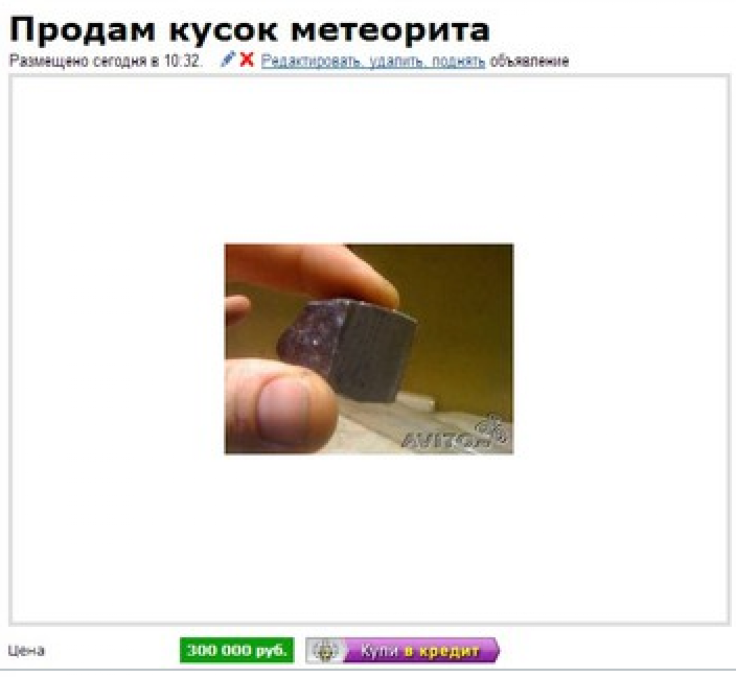Residents Of Chelyabinsk Sell Russian Meteorite Pieces On Classified Website Avito.Ru

Hours after a 10-ton meteor exploded over Siberia on Friday, residents of the Russian city of Chelyabinsk had already begun to list meteorite pieces for sale on Avito.Ru, Russia’s leading website for classified ads.
As many residents of the city were still nursing injuries from the unexpected blast, others were already trying to make a profit, advertising meteorite pieces for sale on auction sites. In one post on Avito.Ru, a user named Andrew advertised 18 pieces of the “Meteor from the news,” for 500 rubles each (the equivalent of $16.61), which he promised would be arriving by plane to Moscow on Saturday from Chelyabinsk.
“There are 18 pieces of size as a wristwatch,” Andrew wrote in Russian on the site. “You can choose as souvenirs or for stories. BOOK ME IN ADVANCE, to snap up FAST!
Another Chelyabinsk resident left an announcement on the site, writing, "Buy a fragment of a meteorite Chelyabinsk, found today at the crash site, photo later. Questions by mail, the price is also negotiable. "
A third user who identified himself as Sergey, asked for 300 thousand rubles (roughly $10,000) for a piece of the space rock. “A piece of the meteor for sale, it’s new,” Sergey wrote, with a photo attached of himself holding a piece of stone, the Russian website Gazeta reported.
The blast reportedly injured more than 1,000 people, according to Russia’s Interior Ministry, the majority of whom were hurt by shards of shattered glass. The New York Times reported that most of the injuries came from the eastern city of Chelyabinsk, a major industrial center known for manufacturing military machinery and nuclear weapons, and formerly, a center of production for weapons-grade plutonium. Russian officials said that there was no evidence of radiation leaks resulting from the meteor’s blast.
Despite the large number of injuries, Vladimir Lipunov, an astrophysicist at the Shternberg State Astronomy Institute, said that the region came away from the incident relatively unscathed.
Lipunov described the area surrounding Chelyabinsk as filled with “dozens of defense factories, including nuclear factories and those involved in production of thermonuclear weapons.”
“No one needs to be told what the Urals is,” Mr. Lipunov told NTV. “A second hit in the same area is unlikely, and everything could have been much, much worse.”
© Copyright IBTimes 2024. All rights reserved.











